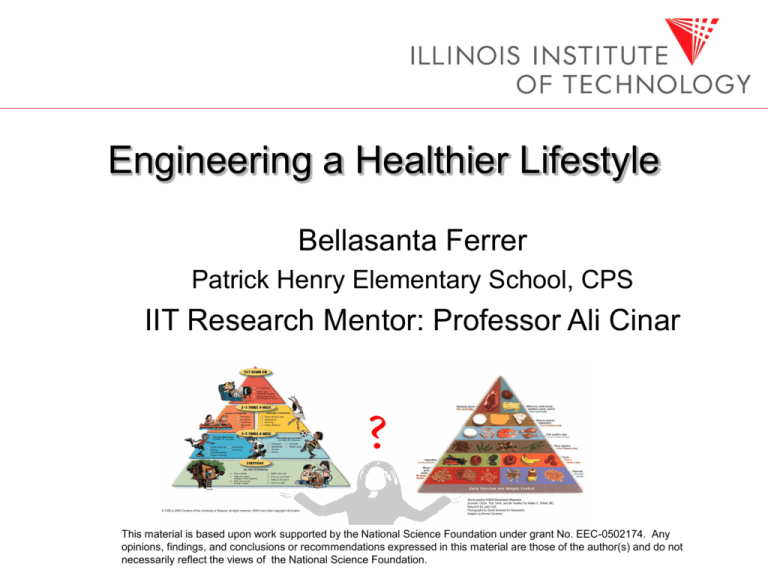
Engineering a Healthier Lifestyle
Bellasanta Ferrer
Patrick Henry Elementary School, CPS
IIT Research Mentor: Professor Ali Cinar
This material is based upon work supported by the National Science Foundation under grant No. EEC-0502174. Any
opinions, findings, and conclusions or recommendations expressed in this material are those of the author(s) and do not
necessarily reflect the views of the National Science Foundation.
Overview
• Subject –Math/Science/Health/Technology
• Target audience – 5th to 8th grade
• Time requirement – 8 to12, 40-minute sessions
Objectives
Content - Knowledge in the use of math, technology,
design, ethics in scientific investigations, &
understanding about scientific inquiry
Inquiry - Formulate questions, devise & conduct
scientific investigations, communicate process &
results to an audience using traditional or
contemporary technologies
Design – A healthier & more informed personal meal &
activity plan
Ethics – Use simulation for safer testing of proposed
meal & activity plan; practice safety in conducting
investigation
Illinois Learning
Standards: State Goals
MATHEMATICS
Collect, organize & analyze data using statistical methods;
predict results; & interpret uncertainty using concepts of
probability
10.B.3 – Formulate questions, devise & conduct experiments or
simulations, gather data, draw conclusions & communicate
results to an audience using traditional methods &
contemporary technologies.
PHYSICAL DEVELOPMENT & HEALTH
Promote & enhance health & well being through the use of
effective communication & decision-making skills
24.B.3 – Apply a decision-making process to an individual health
concern
SCIENCE
Understand the processes of scientific inquiry & technological design
to investigate questions, conduct experiments & solve problems
11.B.2b – Develop a plan, design, & procedure to address the
problem identifying constraints
Understand the fundamental concepts, principles & interconnections
of the life, physical & earth/space science
12.A.4b – Describe structure & organization of cells & tissues that
underlie basic life functions including nutrition, respiration, cellular
transport, biosynthesis & reproduction
Understand the relationships among science, technology & society in
historical & contemporary contexts
13.B.2a – Explain how technology is used in science for a variety of
purposes (e.g. data collection, storage, retrieval, treatment,
measurement, communication of information).
Teacher Notes &
Resources
Engineering is Elementary
http://www.mos.org/doc/1545
The Way We Eat Now
http://www.harvard-magazine.com/on-line/050465.html
Understanding Food Labels
http://www.cfsan.fda.gov/~acrobat/foodlab.pdf
Normal Regulation of Blood Glucose
http://www.endocrineweb.com/insulin.html
Fit for Fun
Reprinted by special permission from Weekly Reader Corporation. Current Health®, is
published by Weekly Reader Corporation. All rights reserved.
©2002, American Heart Association. Permission granted to reproduce for classroom use.
Healthy Weight
Harvard School of Public Health - http://www.hsph.harvard.edu/nutritionsource/healthy_weight.html#weightcontrol
HeartPower! Online
http://www.americanheart.org/presenter.jhtml?identifier=3003357
Examples
What Risks are Related to Nutrition?
Examples
http://www.health.nsw.gov.au/obesity/youth/bmi.html
Photo Researchers, Inc./Carl Purcell/Science Source encarta.msn.com/media
http://www.aces.edu/dept/extcomm/health/march21b02.html
Examples
How Do I Make Informed Food & Activity Choices?
•What’s my BMI, BMR, & WL/H ratio?
•Calories & Glucose Detectives
•How Do I Make Informed Food Choices?
•The Balancing Act: CI=CO, A Simulation
•Personal Food/Activity Plan Presentation
•Microgravity meal & activity plan
Project
• Healthier personal meal and activity plan
• Inquiry: Students devise and conduct scientific
investigations to solve design challenge
• Ethics: Raise contextual ethical issues while
doing the design challenge i.e. injury or damage
to people, property, and the environment or
waste of resources
Materials
• Content Pretest & Posttest
• Food & Activity Diary
• Nutritional Database Software
• Calories Burned, BMI, BMR, & RMR Calculator
• Glucosim Diabetes Simulation Software
• Basic Engineering Design Process
• Design Challenge Rubric
• Continuum of Scientific Inquiry
• Food & Food Labels
Assessment
• Concepts: knowledge about nutrition,
respiration, using math & technology in scientific
investigations, doing & understanding of
scientific inquiry, ethics, decision-making process
related to a healthy life
• Instruments
a) content pre/posttest
b) pre/posttest rubric
c) design challenge rubric
Module Development
Plan
•
•
•
•
•
•
Week 2: Lab work and research
Week 3: Lab work and research
Week 4: Present progress report
Week 5: Module draft
Week 6: Finish module - Rehearse presentation
Week 7: Present module at the RET Workshop




